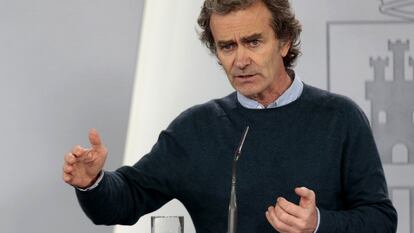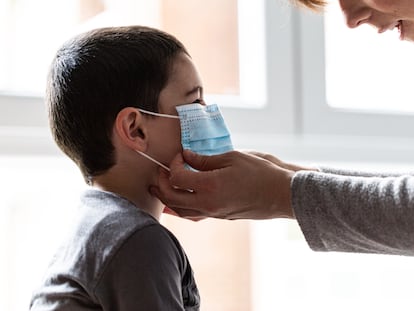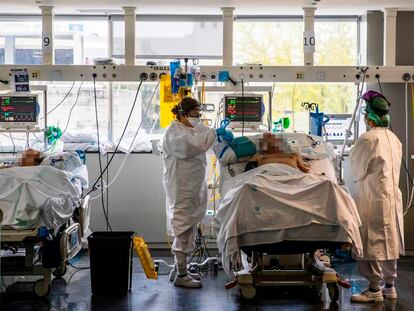Spain will scale back confinement at different speeds, say experts
Health specialists note that the impact of Covid-19 and the ability to cope with the pandemic is not the same across the various regions, provinces and cities

On May 10, barring any further extensions to the state of alarm, Spain will start transitioning back to what many hope will be something similar to the life they had before the Covid-19 pandemic. But experts note that the deescalation will not take place at the same speed everywhere across the country.
“There are regions and provinces and islands where the risk of transmission is zero or close to it,” said Fernando Simón, head of Spain’s Health Emergency Coordination Center, on Tuesday.
Despite having some of the world’s strictest confinement measures – children will only be allowed out for an hour a day starting on Sunday – Spain has been one of the world’s hardest-hit countries, with an official death count of 22,157 victims and over 213,024 infections as of Thursday, although the real figure could be significantly higher. Authorities placed the country in lockdown on March 14, but new research suggests that the coronavirus was already circulating in Spain by mid-February.
On April 8, the Health Ministry announced that it would conduct a serological survey that would reveal the incidence of the SARS-CoV-2 virus in Spain, in line with similar studies already conducted or underway in other countries. But the survey, which should have been a key tool in designing Spain’s deescalation process, has been constantly delayed. According to the latest official statements, testing is due to start on Monday at the earliest and will last for eight weeks.
Difference by regions
While the health official Fernando Simón did not mention any specific regions at his Tuesday briefing, Health Ministry data released on Wednesday showed that registered coronavirus cases grew by less than 1% in the Canary Islands, Murcia and La Rioja, as well as in the exclave cities of Ceuta and Melilla on the northern coast of Africa.

“It’s within reach. If the evolution of the pandemic does not take a turn for the worse, in three weeks we’ll be able to go outside, regardless of the conditions that may be established,” said José Martínez Olmos, who teaches at the Andalusian Public Health School and served as a health official for the Spanish government between 2005 and 2011.
Health experts insist that easing confinement measures is a decision that depends on a reduction of transmission rates, on the healthcare system’s ability to cope with cases, and on the capacity to track infected people and their contacts.
But not all parts of Spain score the same in these categories. “The criteria [for easing the current measures] must be similar, but not everywhere at the same time,” said Simón.
“There will be initial elements in common, and others that might be managed at the regional and even the local level,” said Joan Ramon Villalbí, of the Spanish Society for Public Health and Health Management (Sespas). “There will be a series of small steps that might be faster or slower depending on the place.”
It is possible that at some point, and in some places, we may have to reintroduce temporary restrictive measuresAndrea Burón, Spanish Epidemiology Society
“If in one region or for a specific group, the risk of transmission and contagion is lower, it would be not only logical but desirable to ease restrictions earlier, to prevent the damage that they are causing,” said Andrea Burón, spokesperson for the Spanish Epidemiology Society (SEE), alluding to the mental, social and economic impact of the coronavirus lockdown.
Burón also warns that decisions are being made without any real certainty about their impact, and that “it is possible that at some point and in some places we may have to reintroduce temporary restrictive measures if we observe a new spike in cases. It’s part of the process.”
It is also unclear how much power local and regional governments have to make these decisions.
“The normal thing would be for regional and local authorities to want to ease the central government’s restrictions, rather than to increase them,” said José Ramón Repullo, who teaches health planning and economy at the Carlos III Health Institute.
“If there are differences between the regions, you still cannot prohibit people from traveling from one to another,” said Martínez Olmos. “It would be difficult to create border controls between regions or provinces,” adds Repullo. “But then again these are unusual times.”
English version by Susana Urra.
Tu suscripción se está usando en otro dispositivo
¿Quieres añadir otro usuario a tu suscripción?
Si continúas leyendo en este dispositivo, no se podrá leer en el otro.
FlechaTu suscripción se está usando en otro dispositivo y solo puedes acceder a EL PAÍS desde un dispositivo a la vez.
Si quieres compartir tu cuenta, cambia tu suscripción a la modalidad Premium, así podrás añadir otro usuario. Cada uno accederá con su propia cuenta de email, lo que os permitirá personalizar vuestra experiencia en EL PAÍS.
¿Tienes una suscripción de empresa? Accede aquí para contratar más cuentas.
En el caso de no saber quién está usando tu cuenta, te recomendamos cambiar tu contraseña aquí.
Si decides continuar compartiendo tu cuenta, este mensaje se mostrará en tu dispositivo y en el de la otra persona que está usando tu cuenta de forma indefinida, afectando a tu experiencia de lectura. Puedes consultar aquí los términos y condiciones de la suscripción digital.
More information
Últimas noticias
Welcome to the post-religion era: The idea of Christianity as the absolute truth has become obsolete
‘I thought you would like it’: The risky sexual practice popularized by TV shows and TikTok
The digitalization of tourism: ‘They promise experiences and gave us the worst possible one’
Mexican peso defies uncertainty with forecasts of a new period of stability in 2026
Most viewed
- Sinaloa Cartel war is taking its toll on Los Chapitos
- Oona Chaplin: ‘I told James Cameron that I was living in a treehouse and starting a permaculture project with a friend’
- Reinhard Genzel, Nobel laureate in physics: ‘One-minute videos will never give you the truth’
- Why the price of coffee has skyrocketed: from Brazilian plantations to specialty coffee houses
- Silver prices are going crazy: This is what’s fueling the rally










































